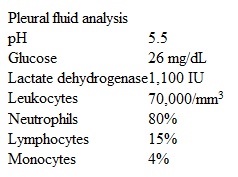A 30-month-old boy is admitted to the hospital due to a 3-day history of fever, cough, and dyspnea. He has a history of recurrent infections, including 4 episodes of cervical lymphadenitis that responded slowly to treatment with clindamycin. Temperature is 38.2 C (100.8 F) , blood pressure is 90/60 mm Hg, pulse is 100/min, and respirations are 30/min. The anterior cervical lymph nodes are palpated bilaterally with several firm, 1- to 1.5-cm nodes that are nontender, nonfluctuant, and without overlying erythema. Breath sounds are diminished at the left lower lung base. The abdomen is soft, nontender, and nondistended without hepatosplenomegaly. A chest x-ray reveals a patchy infiltrate in the left lower lobe and a moderately sized pleural effusion. A chest tube is placed, and cloudy fluid is obtained. Laboratory results are as follows:  Microscopy of pleural fluid shows numerous, intact gram-negative rods within neutrophils; cultures ultimately grow Burkholderia cepacia. The patient's condition improves with appropriate treatment. Which of the following is most appropriate for infection prophylaxis for this patient?
Microscopy of pleural fluid shows numerous, intact gram-negative rods within neutrophils; cultures ultimately grow Burkholderia cepacia. The patient's condition improves with appropriate treatment. Which of the following is most appropriate for infection prophylaxis for this patient?
A) Azithromycin and palivizumab
B) Granulocyte colony-stimulating factor
C) Intravenous immunoglobulin
D) Trimethoprim-sulfamethoxazole and itraconazole
Correct Answer:
Verified
Q1: Over the course of 5 years, a
Q2: The following advertisement is focused on LDL
Q3: A cross-sectional study is investigating the association
Q5: A 2-month-old girl is brought to the
Q6: A large study examined the role of
Q8: A 14-year-old boy is brought to the
Q9: Researchers are interested in determining whether oral
Q10: A study was conducted to assess the
Q11: A 71-year-old man comes to the office
Q269: A 2-year-old boy is brought to the
Unlock this Answer For Free Now!
View this answer and more for free by performing one of the following actions

Scan the QR code to install the App and get 2 free unlocks

Unlock quizzes for free by uploading documents